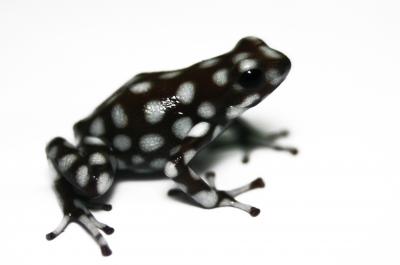This is the first study to show that the Andes have been a major source of diversity for the Amazon basin, one of the largest reservoirs of biological diversity on Earth. The finding runs counter to the idea that Amazonian diversity is the result of evolution only within the tropical forest itself.
It has been assumed that much of the evolution of biodiversity in the Amazon basin occurred over the last one to two million years, a mere snapshot in time.

Dendrobates mysteriosus - Poison frog from the transition between the Andes and Amazonia in northeastern Peru. Credit: Juan Carlos Santos, the University of Texas at Austin
"Basically, the Amazon basin is a 'melting pot' for South American frogs," says graduate student Juan Santos, lead author of the study. "Poison frogs there have come from multiple places of origin, notably the Andes Mountains, over many millions of years. We have shown that you cannot understand Amazonian biodiversity by looking only in the basin. Adjacent regions have played a major role."
Santos and Dr. David Cannatella, professor of integrative biology, peered about 45 million years into the past using novel biogeographical techniques to create a deep evolutionary history of poison frogs in space and time. Because of the lack of an extensive fossil record for the tropical forest, their work used DNA sequences to discover the frogs' evolutionary history.
The poison frogs, or dendrobatids, are diverse and widely distributed across the Neotropics, an area that includes Central and South America. The scientists created an evolutionary tree, or phylogeny, using 223 of the 353 species of poison frogs known from throughout this region.
In analyzing the evolutionary relationships among the poison frogs, they discovered that Amazonian diversity is the result of at least 14 dispersals of ancestral frogs into the region beginning about 23 million years ago.
All living Amazonian poison frogs evolved from these ancestors, most of which (11 dispersals) came from the Andes Mountains.
The Amazon basin has changed dramatically over that long time. A large inland system of water has come and gone, the Andes Mountains started their uplift (about 15 million years ago) and the Amazon River was formed (about nine million years ago).
Most of the frog dispersals from the Andes occurred between one and seven million years ago, when the modern tropical rainforest of the Amazon River basin was forming.
"There was a repeated dispersal of frogs from the foothills of the Andes after the extensive inland wetlands retreated from the Amazon," says Santos.
These frogs then evolved into about 70 species found today in the Amazon basin.
The scientists also discovered that frogs have historically immigrated out of the Amazon basin to adjacent areas, and to and from other regions within the Neotropics.
Evolution and diversification of the poison frogs is ongoing, especially in the Amazon rainforest, the Chocó (a narrow region of tropical forest along the northwest Pacific Coast of South America) and in adjacent Central America.
Cannatella says many other tropical plants and animals in the Amazon may share this more complex geographical and temporal history with the poison frogs.
"The Amazon rainforest is not just gradually accumulating diversity over time," says Cannatella. "Ancestral frog species moved into and out of the area, and we can predict that other organisms restricted to these wet tropical forests may show a similar pattern of dispersal, evolution and diversification."
Funding provided by the "Assembling the Tree of Life" program of the National Science Foundation and Ecology, Evolution and Behavior graduate research fellowships at The University of Texas at Austin.
Citation: Santos JC, Coloma LA, Summers K, Caldwell JP, Ree R, et al. (2009) Amazonian Amphibian Diversity Is Primarily Derived from Late Miocene Andean Lineages. PLoS Biol 7(3): e1000056 doi:10.1371/journal.pbio.1000056






Comments